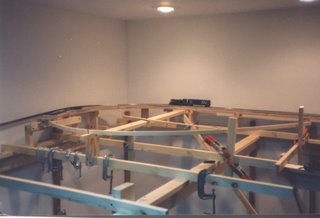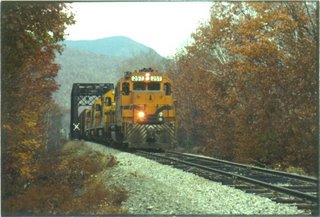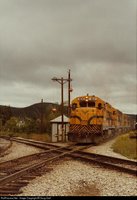 I dug through some old photos and found 2 pictures from about 1988. Not the greatest quality, but they do show what we were doing at the time (Interesting how today with digital cameras I take pictures of everything and sort through them on the computer, but when it was film that had to be developed I was much more selective before pressing the button).
I dug through some old photos and found 2 pictures from about 1988. Not the greatest quality, but they do show what we were doing at the time (Interesting how today with digital cameras I take pictures of everything and sort through them on the computer, but when it was film that had to be developed I was much more selective before pressing the button).The first photo here is from Glenn and Diane's layout. It depicted the Rutland from Bellows Falls to Rutland. This was the first scene, Gassetts, VT. Diane really did some great scenery here and we did get the foreground and fascia in later. To the left, the layout crossed the entrance to the room on a drop bridge into a workshop area. Under the top level is the lower level. The layout used an alternating upper level/lower level scene, giving space between each town on each level, with the backdrop creating a shadow box type look.
 In the next picture, this is to the right of the Gassetts picture, turning 90 degrees. Here the layout continued down the wall, across the far wall and back up the wall to the left. At this time, Rutland yard (and the hidden Whitehall staging yard) were not built. The 2 modules we first built as a group are temporarily added here to the end of the mainline so we could run trains back and forth. I really wish I had more photos documenting our accomplishments on this layout.
In the next picture, this is to the right of the Gassetts picture, turning 90 degrees. Here the layout continued down the wall, across the far wall and back up the wall to the left. At this time, Rutland yard (and the hidden Whitehall staging yard) were not built. The 2 modules we first built as a group are temporarily added here to the end of the mainline so we could run trains back and forth. I really wish I had more photos documenting our accomplishments on this layout.There were a lot of good times working on the layout with Glenn, Diane and our friend Anton, plus a few others here and there. The SJW concept worked well for us. We all learned a lot about building layouts and we got a lot more accomplished then if we worked alone. A few years later we started work on a layout in my home. Glenn helped a lot getting the basement area ready and then handlaying some track.
 Here you see me doing some early benchwork assembly on the area of the layout to depict Bartlett. This photo is from October 1995. A lot of the concepts learned on Glenn's layout and then this layout were applied to my current layout, such as the benchwork style and spline roadbed assembly.
Here you see me doing some early benchwork assembly on the area of the layout to depict Bartlett. This photo is from October 1995. A lot of the concepts learned on Glenn's layout and then this layout were applied to my current layout, such as the benchwork style and spline roadbed assembly.In this last shot, we see more of the Bartlett benchwork completed. The corner location meant that we were going to include the wye in Bartlett. The tail leg was going to be used for a continuous run option and that is where the loco and boxcar were sitting at the time. This area progressed to full trackage with handlaid code 70 and code 55 track featuring switches built by Glenn. A move from this house in 1996 ended the layout. But one thing I realized from the trackplan and what I had built is that the layout I was building, Portland staging feeding into Bartlett, Crawford Notch, Whitefield and finally St. Johnsbury, was going to be faithful but did not offer too much in the way of operations.
 The St. J area would have the most action, including north and south Canadian Pacific staging and a short Lamoille Valley staging track in the electrical closet. These lessons were important as I planned my current layout and found that focusing on St. J offered the most operating potential for the era and geographical area I wanted to model.
The St. J area would have the most action, including north and south Canadian Pacific staging and a short Lamoille Valley staging track in the electrical closet. These lessons were important as I planned my current layout and found that focusing on St. J offered the most operating potential for the era and geographical area I wanted to model.As for the South Jersey Workshop, Diane moved to New York a few years ago and Anton is curently living and working in Maryland. Anton did help out on a lot of the initial benchwork on the current layout when it was started in 2003. So the SJW is somewhat in hibernation I guess, pending visits from past members for work sessions (hint, hint) or bringing some new people into the fold. My advice: In the area where you live, look into establishing a round-robin group like this. There are many benefits and it can really boost your ability to get things accomplished on the layout. You'll make some great friends along the way too!


